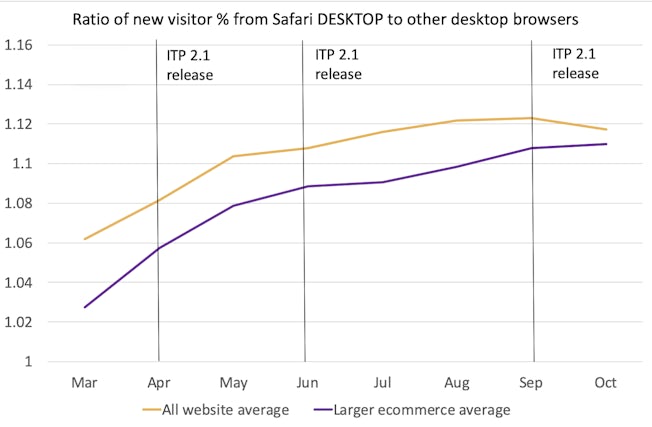http://feedproxy.google.com/~r/OnlineMarketingSEOBlog/~3/auJdwRT8trk/


Marketing leaders are at the forefront of a seismic transformation that continues to play out as we enter a new decade.
Organizational dynamics are realigning. Power balances are shifting. Trust – both internal and external – is emerging as the most essential crux in business success. For people like Adi Bachar-Reske, it’s an exhilarating time to be leading the charge.
Her history in marketing dates back multiple decades, so she’s been helping shape this evolution. “Twenty years ago, everybody’s in a suit. I was the only woman in the room, always,” she says. “It has changed a lot.”
Today, she finds that she no longer tends to be the only woman in the room (though the balance is still a ways from where it needs to be), and that’s far from the only change she’s observed in her marketing leadership positions — most recently at Provenir, where she served as Vice President of Marketing before moving into a solo consulting role late last year.
Much of her experience, including at Provenir, has come in the financial technology (FinTech) space, so during my interview with her for the Break Free B2B series, we zeroed in on some key topics tied to the vertical: proving the revenue impact of marketing, staying on top of content consumption trends, and building trust with customers when sensitive data is in play.
Break Free B2B Interview with Adi Bachar-Reske
[youtube https://www.youtube.com/watch?v=shbOttuRJeI]
If you’re interested in checking out a particular portion of the discussion, you can find a quick general outline below, as well as a few excerpts that stood out to us.
- 1:00 — Introduction to Adi
- 2:00 — Provenir’s marketing philosophies
- 4:00 — How are content consumption trends changing?
- 10:30 — Building trust in the financial industry
- 13:15 — How technology helps with personalization and trust
- 16:00 — Building trust in marketing internally
- 18:45 — Which types of content help sales most?
- 22:00 — How can B2B marketers break free?
- 24:00 — How to balance taking risks with playing it safe
Nick: What are you seeing from your end in terms of shifting content consumption trends and shortening attention spans?
Adi: I find that myself, I don’t read books anymore, my eyes get really tired and I just don’t have the time to sit down and actually read, but what I do do, I got addicted to Audible right? So I walk through a long airport, or I sit down and wait for my daughter to finish her guitar lesson, and I’ll just put it in my ears. I read at least two books a month that way and I love it because of the way Audible, they’ve changed too right?
So you’ve got the authors now reading the story. It’s a bit like a TED Talk that lasts for a few hours, which is brilliant. And the same for blogs. Blogs were the big thing a few years ago, but again, we don’t have time to read, so we did this test here. We took some of the blogs and we kind of condensed them, shrank them up into a one-minute video. It was the same content, but obviously a lot less. And we captured the essence of it, and the engagement was just phenomenal. I think we’re all very curious people in the same way we were 10 or 20 years ago, we just consume information differently.
[bctt tweet="I think we're all very curious people in the same way we were 10 or 20 years ago, we just consume information differently. @AdiBacharReske #ContentConsumption #BreakFreeB2B" username="toprank"]Nick: Being in the finance industry, I have to imagine that trust, data security, privacy, those are big issues. What are you seeing from your perspective as far as the condition of trust between customers and brands
Adi: Years ago the saying was, nobody’s going to lose their job for choosing IBM. If you were a big brand, you were safe, and the financial institution had an immediate trust in you. Easy peasy. But if you were a small brand then it was difficult to get in. They didn’t trust you. You were just small, maybe you’ll disappear tomorrow. It’s funny, things have changed.
I speak to my customers, large institutions and small institutions, all the time and I ask them: why did you choose us? We’re not a big player, we’re not an IBM. In the past year or so, the answer I get is kind of surprising. They say, we chose you because you are small. We chose you because we wanted to work with somebody who’s nimble, who can work with us, who can focus on us, because all these large businesses, you know they have other things to worry about. They may not focus on us, they may not sit down, listen to what we need, build something special for us …
So these days, the way you build the trust is showing how nimble and flexible you can be. Both in your development and your product, but also it has to be reflected in your marketing and your digital presence. You have to look accessible, you have to look open.
[bctt tweet="These days, the way you build trust is showing how nimble and flexible you can be. Both in your development and your product, but also it has to be reflected in your marketing and your digital presence. @AdiBacharReske #BreakFreeB2B" username="toprank"]Nick: As a marketing leader who regularly interfaces with other leadership in the company, what are your strategies for building trust internally, across departments?
Adi: Numbers, numbers, numbers. So again, I’ve been around for a long time and marketers used to be the first one — when the quota hasn’t been met or something happened like that — the marketers were the first people out the door. Why? Because we couldn’t really show any numbers.
You know, we spend all that money on an event, or we spend all that money on a beautiful site … What did it do for us? What did we get back for it? Nothing, nobody knows really. I mean there were anecdotes here and there but we don’t really know. So over the years they created all these beautiful technologies that help us measure that, and it’s up to us to create the KPIs that ensure the bottom line.
So my strategy from day one was to show the bottom line. We spent X, and therefore as a result we had Y inbound leads that turned into whatever converted and whatever closed … With management, the way I grew my team is, I was able to show the numbers and how they grew, and with that I got more investment, and I was able to show more and more and more.
Stay tuned to the TopRank Marketing Blog and subscribe to our YouTube channel for more Break Free B2B interviews. Here are a few interviews to whet your appetite:
- Break Free B2B Series: Hal Werner on the Intersection of Marketing Creativity and Analytics
- Break Free B2B Series: Maliha Aqeel on How to Ace B2B Company Culture
- Break Free B2B Series: Amanda Todorovich on Creating Content that Pays Off
The post Break Free B2B Series: Adi Bachar-Reske on Taking the Lead in the Evolution of B2B Content Marketing appeared first on Online Marketing Blog – TopRank®.











